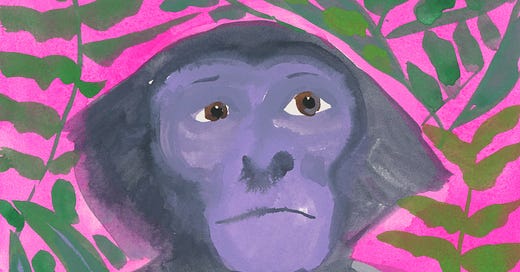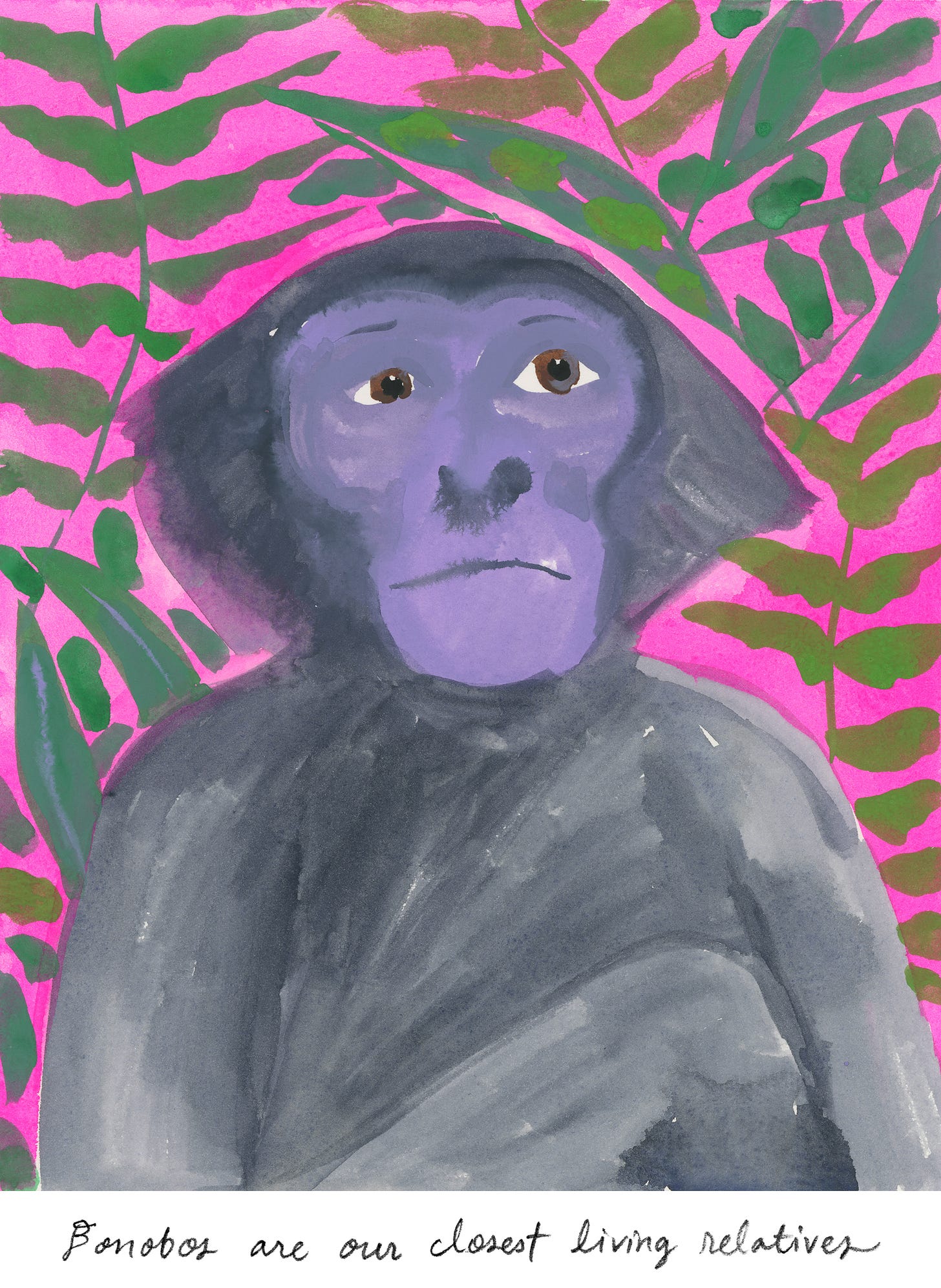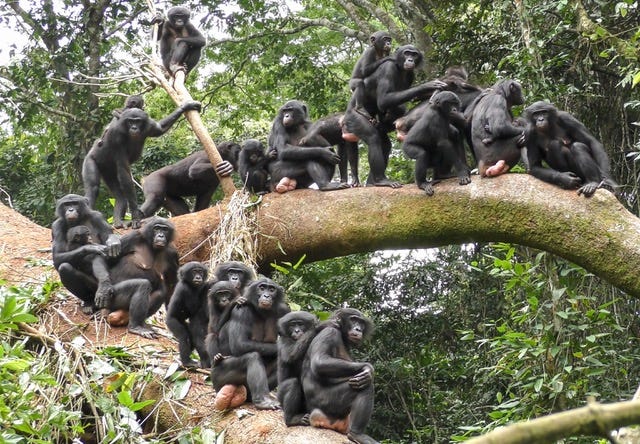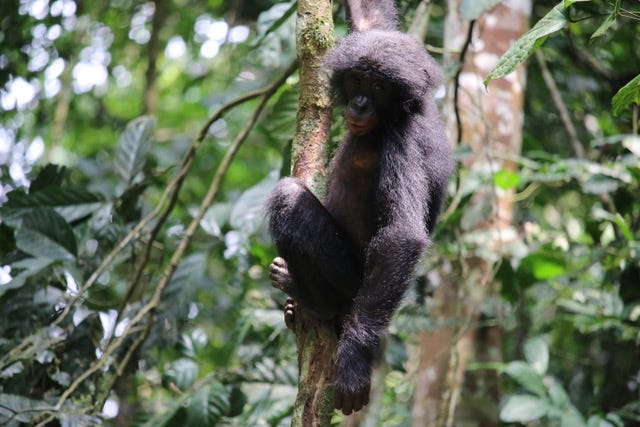Hi, friends — Happy Valentine’s and Happy World Bonobo Day! This is a special edition in which we consider the very endangered bonobo (Pan paniscus), our closest living relative. I interviewed Ashley Stone, who founded World Bonobo Day after spending time with bonobos in the Democratic Republic of Congo. She gives a glimpse of what it’s like to see a bonobo in the wild and to spend time with the people who are working to rescue them.
Bonobos are socially complex and emotionally acute. We may recognize ourselves in them, but their version of community, empathy, and care—the same and not-same as humans—is visionary. — Amy Jean
Bonobo communities are centered around the oldest, wisest females. Females cooperate and take care of each other and make decisions about when and where to forage. They attend each other in labor and help take care of each other’s babies. Males follow their lead and stay with their mothers for life.
Bonobos live only in the Congo Basin, separated from chimpanzees by the Congo River. They share 99% of their DNA with chimps but have evolved very differently, perhaps because of food stability in their environment. Bonobos are remarkably less aggressive than chimpanzees, whose male-dominated competitive instincts often lead to violent conflict.
Bonobos are extremely social and empathic, able to read the moods of others. They groom each other, pet each other, lounge and feed each other, take naps together, and share their food with strangers. They also rub their genitals together in an astounding array of possibilities, all socially acceptable for bonobos. These behaviors help alleviate conflict, and of course there is conflict—they are smart, strong creatures.
Bonobos are endangered due to habitat loss, poaching, and the poverty and political instability that comes after a region has been colonized and exploited for decades. Bonobos are part of a fabric that has been ruptured, and healing is a long process that involves people, animals, and the land.
Ashley Stone founded The Bonobo Project and led the charge to create World Bonobo Day on February 14. She was kind enough to answer a few questions by email (lightly edited and condensed for space).
AJP: When was the first time you saw a bonobo in person?
AS: I first learned about bonobos in an undergraduate anthropology class by Dr. Frans de Waal at Emory University in the late 1990s. Years later, in January 2014, I was invited by Claudine André to spend a week at Lola ya Bonobo, a sanctuary for bonobos that she founded in 1994 in Kinshasa, Democratic Republic of Congo (DRC).
At Lola ya Bonobo, professionals care for and rehabilitate bonobo orphans so that they can hopefully return to the wild. During my time there, I received training and was able to help in the nursery, where I met a bonobo named Boma. She and I had the opportunity to spend quality time together, and each day Boma would vocalize when she saw me coming. Boma vacillated between jumping all over me and sitting quietly in my lap to groom my hair looking for bugs like I was a fellow bonobo.
AJP: How does it feel to look a bonobo in the eyes? Are you able to understand their facial expressions?
AS: There’s nothing like looking into the eyes of a bonobo. I’ve come to believe that we share some kind of instinctual, cross-species understanding that is difficult to put into words, but perhaps it stems from our mutual capacity for empathy. If you spend enough time with bonobos, you can certainly understand their facial expressions, vocalizations and social bonds.
On one occasion at the sanctuary, I was helping with an extremely rambunctious toddler and we were next to another surrogate mama, Yvonne, who was taking care of a much calmer youngster. I don’t speak French or Lingala, but I gestured to Yvonne that the two bonobos should change positions so I could have a break from the wild one. In the very next instant, the two bonobos got up from each of us and changed positions as if they exactly understood what I was suggesting. It blew my mind.
AJP: Can you describe a time you saw bonobos in the wild?
AS: In the summer of 2017, I had the opportunity to spend a few weeks in Wamba, DRC with Dr. Takeshi Furuichi observing bonobos in the wild. The experience solidified my passion for conservation as well as my commitment to the people of Congo working to save bonobos and preserve their habitat.
I remember there was one very curious juvenile who swung from branch to branch all around me to get a closer look. I never felt worried about his intentions, as he reminded me of my own children, harmlessly testing boundaries.
Bonobos are not proprietary, meaning they don’t defend territory or mates or food sources. When a group of bonobos comes upon another group in the wild, they may create a lot of noise and chaos initially, but they do not engage in fatal violence. In fact, the groups often hang out together for hours before moving on from each other.
I spent those days observing bonobos in the forests and saw them groom each other for hours, play and nap in the trees, eat their fill of fruit, mushrooms and plants, and of course do what bonobos do—rub, touch and have lots of sexual interactions. After all, they are known as the “make love, not war” great ape.
AJP: What is the one thing you want people to know about bonobos?
AS: Bonobos are uniquely matriarchal, uniquely non-homicidal and uniquely loving, and they are worth our focused efforts to protect them from extinction. Bonobos are emotionally intelligent in ways we need to continue to study in order to understand our own emotional evolution.
AJP: What is World Bonobo Day?
AS: After my experience at Lola ya Bonobo, I made a promise to do all that I could to help bonobos from becoming extinct and to spread the word about their amazing nature. Creating World Bonobo Day was a step toward those goals.
World Bonobo Day is an opportunity to draw the connection between an internationally celebrated day of love and the loving nature of our closest genetic relatives. Bonobos have never been observed to kill one another, unlike all of the other great apes (humans, gorillas, chimpanzees and orangutans). The dominant way in which bonobos reduce tension is through sexual touching, rubbing and intercourse in every possible combination rather than extreme aggression. What better day to highlight bonobos than on February 14!
A pair of orphaned bonobos being cared for by the staff at Lola ya Bonobo, 2014. Photo: Ashley Stone
Wild bonobos from Wamba, DRC. Photo: Takumasa Yokoyama
A young, very curious, wild male bonobo from Wamba. Photo: Ashley Stone
Bonobo links—
Friends of Bonobos/Lola ya Bonobo has a great website with lots of information and ways to get involved—plus their YouTube channel is fantastic for at least a full afternoon of watching bonobos (I may have watched them all, here). I highly recommend this short documentary. Also Instagram for a quick vid or two.
Would you like to watch young bonobos jump for joy on a trampoline? Yes, please. [Friends of Bonobos via YouTube]
“In the Bonobo World, Female Camaraderie Prevails” by Natalie Angier in the New York Times
Thanks to—
Many thanks to Jean Fleming of the Pan African Sanctuary Alliance (PASA) for contacting me and introducing me to Karen Kemp at Lola ya Bonobo—and to Ashley Stone for being so generous with her time.
Also—
My Valentine bonobo drawing is for sale, here! Proceeds go to Lola ya Bonobo <333
Wild Life #39 / this newsletter is a place to learn about the life around us, one empathic great ape at a time. I do this because I’m not sure what to do about the millions of species in danger of extinction. It means something to see and enjoy the life around us. Thanks for reading and sharing with your sweetheart.








Wonderful article, Amy! Would love to see them in the wild.
Lots of lessons for Homo sapiens here. Great stuff!